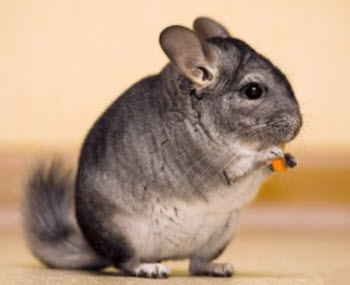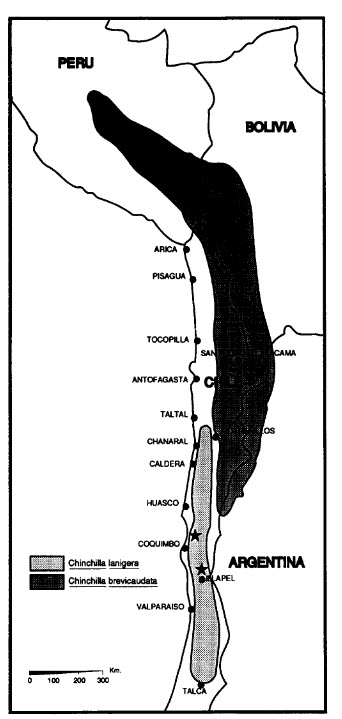The Short-tailed chinchilla (Chinchilla chinchilla) is one of two species in the genus Chinchilla.
 Compared to the other species, the short-tailed chinchilla:
Compared to the other species, the short-tailed chinchilla:
- Have a thicker neck and shoulders
- Have a much shorter tail
- Have shorter ears
The adult short-tailed chinchilla is circa 25 – 50 cm long and will usually weigh 1 kg – 1.4 kg. The hind legs are much longer and more powerful than the front ones.
The domesticated chinchillas in the pet trade are believed to be descendants not of the short-tailed chinchilla but of the long-tailed one (Chinchilla lanigera).
Scientific classification
| Kingdom: | Animalia |
| Phylum: | Chordata |
| Class: | Mammalia |
| Order: | Rodentia |
| Family: | Chinchillidae |
| Genus: | Chinchilla |
| Species: | Chinchilla chinchilla |
Names
In English, the Short-tailed chinchilla is known under various names, including Royal chinchilla, Peruvian chinchilla and Bolivian chinchilla.
The species old scientific name is Chinchilla brevicaudata (Waterhouse, 1848). If you are looking for information about Chinchilla chinchilla in older sources, this is the name to look for.
 Range
Range
The short-tailed chinchilla lives in the Andes Mountains in western South America. Today, the only known wild populations are in Chile, but the original range is believed to have extended into neighboring countries.
This map shows the respective ranges for Chinchilla chinchilla and Chinchilla lanigera in the past, but the old name for C. chinchilla is used: C. brevicaudata.
As you can see, the range for C. brevicaudata (now C. chinchilla) includes parts of Peru, Bolivia, Chile and Argentina, while C. lanigera is limited to Chile. Please note that this information is from the late 20th century. We do not know much about what the respective ranges looked like before the extensive fur hunting that commenced in the 1820s. The practice of hunting chinchilla is much older than this, but the 1820s marks the start of chinchilla hunting on a much larger scale than before.
Conservation
Both Chinchilla chinchilla and Chinchilla lanigera are listed as Endangered by the IUCN.
Chinchilla chinchilla was listed as Critically Endangered in 2006, but was reclassified as Endangered in 2016 due to limited recovery in some areas.
As early as the 1890s, conservation measures were implemented for the short-tailed chinchilla in Chile since it was on the brink of extinction. The measures were not enforced.
The first international effort to ban chinchilla hunting is from 1910, when Chile, Bolivia, Peru and Argentina signed a treaty. Regrettably, the treaty resulted in increased prices for chinchilla pelts, which in turn made the remaining populations more desirable for poachers.
In 1929, Chile passed its own law for the protection of Chinchillas, and this law became somewhat more effective than the previous efforts. It would take until the 1980s before the law was really strongly enforced.
